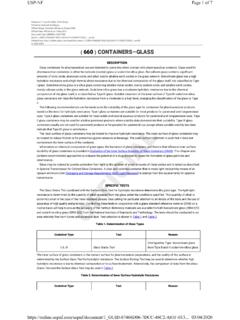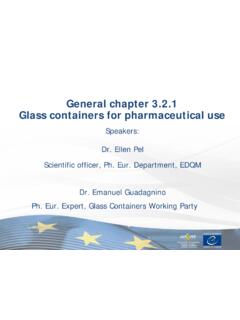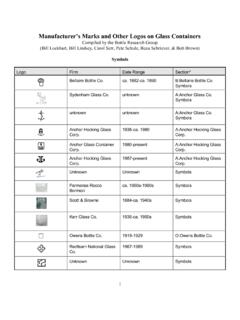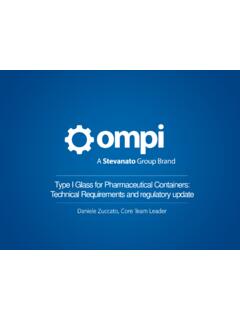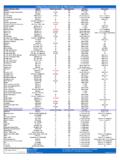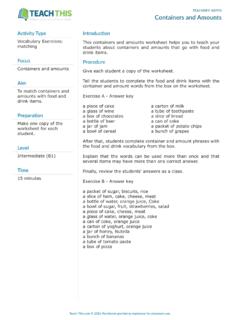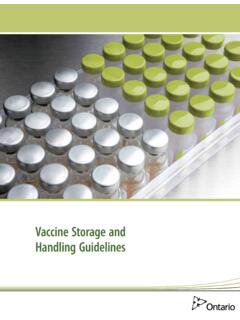Transcription of 3.2.1. Glass containers for pharmaceutical use 01/2008 ...
1 EUROPEAN PHARMACOPOEIA Glass containers for pharmaceutical use01/2008 CONTAINERSA container for pharmaceutical use is an article that containsor is intended to contain a product and is, or may be, in directcontact with it. The closure is a part of the container (see General Notices section ) is so designedthat the contents may be removed in a manner appropriateto the intended use of the preparation. It provides a varyingdegree of protection depending on the nature of the productand the hazards of the environment, and minimises the lossof constituents. The container does not interact physically orchemically with the contents in a way that alters their qualitybeyond the limits tolerated by official container . A single-dose container holds a quantityof the preparation intended for total or partial use on 1 container . A multidose container holds a quantity ofthe preparation suitable for 2 or more container .
2 A well-closed container protects thecontents from contamination with extraneous solids and liquidsand from loss of contents under ordinary conditions of handling,storage and container . An airtight container is impermeable tosolids, liquids and gases under ordinary conditions of handling,storage and transport. If the container is intended to be openedon more than 1 occasion, it must be so designed that it remainsairtight after container . A sealed container is a container closed byfusion of the material of the container . A tamper-proof container is a closedcontainer fitted with a device that reveals irreversibly whetherthe container has been container . A container that is fitted with a closurethat prevents opening by Glass containers FORPHARMACEUTICAL USEG lass containers for pharmaceutical use are Glass articlesintended to come into direct contact with glassis highly transparent in the visible glassis obtained by the addition of small amountsof metal oxides, chosen according to the desired glassis a borosilicate Glass containing significantamounts of boric oxide, aluminium oxide alkali and/or alkalineearth oxides.
3 Due to its composition neutral Glass has a highhydrolytic resistance and a high thermal shock glassis a silica Glass containing alkali metaloxides, mainly sodium oxide and alkaline earth oxides, mainlycalcium oxide. Due to its composition soda-lime-silica Glass hasonly a moderate hydrolytic hydrolytic stability of Glass containers for pharmaceuticaluse is expressed by the resistance to the release of solublemineral substances into water under the prescribed conditionsof contact between the inner surface of the container or glassgrains and water. The hydrolytic resistance is evaluated bytitrating released alkali. According to their hydrolytic resistance, Glass containers are classified as follows: Type I Glass containers : neutral Glass , with a high hydrolyticresistance due to the chemical composition of the Glass itself; Type II Glass containers : usually of soda-lime-silica glasswith a high hydrolytic resistance resulting from suitabletreatment of the surface.
4 Type III Glass containers : usually of soda-lime-silica glasswith only moderate hydrolytic following italicised statements constitute generalrecommendations concerning the type of Glass container thatmay be used for different types of pharmaceutical manufacturer of a pharmaceutical product is responsiblefor ensuring the suitability of the chosen , aqueous preparations whether or not for III Glass containers are in general suitable fornon-aqueous preparations for parenteral administration, forpowders for parenteral administration (except for freeze-driedpreparations) and for preparations not for containers with a hydrolytic resistance higher than thatrecommended above for a particular type of preparation maygenerally also be container chosen for a given preparation shall be such thatthe Glass material does not release substances in quantitiessufficient to affect the stability of the preparation or to presenta risk of toxicity.
5 In justified cases, it may be necessary to havedetailed information on the Glass composition, so that thepotential hazards can be for parenteral administration are normallypresented in colourless Glass , but coloured Glass may be used forsubstances known to be light-sensitive. Colourless or colouredglass is used for the other pharmaceutical preparations. It isrecommended that all Glass containers for liquid preparationsand for powders for parenteral administration permit the visualinspection of the inner surface of Glass containers may be specially treatedto improve hydrolytic resistance, to confer water-repellancy,etc. The outer surface may also be treated, for example toreduce friction and to improve resistance to abrasion. The outertreatment is such that it does not contaminate the inner surfaceof the for type I Glass containers , Glass containers forpharmaceutical preparations are not to be re-used. Containersfor human blood and blood components must not be containers for pharmaceutical use comply with therelevant test or tests for hydrolytic resistance.
6 When glasscontainers have non- Glass components, the tests apply only tothe Glass part of the define the quality of Glass containers according to theintended use, one or more of the following tests are for hydrolytic resistance are carried out to define the typeof Glass (I, II or III) and to control its hydrolytic addition, containers for aqueous parenteral preparations aretested for arsenic release and coloured Glass containers aretested for spectral RESISTANCET able Types of glassType of containerTest to be performedType I and type II Glass containers (to distinguish from type III glasscontainers)Test A (surface test)Type I Glass containers (to distinguishfrom type II and type III glasscontainers)TestB(glassgrainstest)or testC(etching test)Type I and type II Glass containerswhere it is necessary to determinewhether the high hydrolytic resistanceis due to the chemical composition orto the surface treatmentTests A and B, or tests A and CThe test is carried out by titration of the extract solutionsobtained under the conditions described for tests A, B and Notices (1) apply to all monographs and other Glass containers for pharmaceutical useEUROPEAN PHARMACOPOEIA an autoclave capable of maintaining a temperature of121 C 1 C, equipped with a thermometer or a calibratedthermocouple recorder, a pressure gauge, a vent cock and atray, of sufficient capacity to accommodate above the waterlevel the number of containers needed to carry out the test;clean the autoclave vessel and all ancillary equipmentthoroughly before use with water R; burettes with a suitable capacity; one-mark volumetric flasks, with a capacity of 1000 mL.
7 Pipettesandbeakers; conical flasks with a capacity of 100 mL and 250 mL; awater-bath; a metal foil ( aluminium, stainless steel).Flasks and beakers shall have been already used for the testor have been filled withwater Randkeptinanautoclaveat121 C at least for 1 h before being OF THE FILLING VOLUMET hefillingvolumeisthevolumeofwatertobefil ledinthecontainer for the purpose of the test. For vials and bottlesthe filling volume is 90 per cent of the brimful capacity. Forampoules it is the volume up to the height of the and bottles. Select, at random, 6 containers from thesample lot, or 3 if their capacity exceeds 100 mL, and removeany dirt or debris. Weigh the empty containers with an accuracyof g. Place the containers on a horizontal surface andfill them withdistilled water Runtil about the rim edge,avoiding overflow and introduction of air bubbles. Adjust theliquid levels to the brimful line. Weigh the filled containers toobtain the mass of the water expressed to 2 decimal places forcontainers having a nominal volume less or equal to 30 mL,and expressed to 1 decimal place for containers having anominal volume greater than 30 mL.
8 Calculate the mean valueof the brimful capacity in millilitres and multiply it by Thisvolume, expressed to 1 decimal place, is the filling volume forthe particular container Place at least 6 dry ampoules on a flat, horizontalsurface and fill them withdistilled water Rfrom a burette,until the water reaches point A, where the body of the ampouledeclines to the shoulder (see Figure ). Read thecapacities (expressed to 2 decimal places) and calculate themean value. This volume, expressed to 1 decimal place, is thefilling volume for the particular ampoule lot. The filling volumemay also be determined by Filling volume of ampoules (up to point A)TEST A. HYDROLYTIC RESISTANCE OF THE INNERSURFACES OF Glass containers (SURFACE TEST)The determination is carried out on unused containers . Thevolumes of the test liquid necessary for the final determinationare indicated in Table Volume of test liquid and number of titrationsFilling volume (mL)Volume of test liquidfor one titration (mL)Number of titrationsUp to 3 and up to 30 and up to Remove any debris or dust.
9 Shortly before the test,rinse each container carefully at least twice withwater Randallow to stand. Immediately before testing empty the containers ,rinse once withwater Rthen withwater R1and allow to the cleaning procedure from the first rinsing in notless than 20 min and not more than 25 closed ampoules on a water-bath or in an air-oven at about50 C for approximately 2 min before opening; do not rinsebefore and heating. The containers are filled withwater R1upto the filling volume. containers in the form of cartridges orprefilled syringes are closed in a suitable manner with materialthat does not interfere with the test. Each container includingampoules shall be loosely capped with an inert material such asa dish of neutral Glass or aluminium foil previously rinsed withwater R. Place the containers on the tray of the autoclave. Placethetrayintheautoclavecontainingaqua ntityofwater Rsuchthat the tray remains clear of the water.
10 Close the autoclave andcarry out the following operations: heat the autoclave to 100 C and allow the steam to issuefrom the vent cock for 10 min; closetheventcockandraisethetemperaturefr om100 Cto121 Catarateof1 Cpermin; maintainthetemperatureat121 1 Cfor60 1min; lower the temperature from 121 C to 100 C at a rate C per min, venting to prevent vacuum; do not open the autoclave before it has cooled down to 95 C; remove the containers from the autoclave using normalprecautions, place them in a water-bath at 80 C, and runcold tap water, taking care that the water does not contactthe loose foil caps to avoid contamination of the extractionsolution; cooling time does not exceed 30 extraction solutions are analysed by titration according tothe method described Carry out the titration within 1 h of removal of thecontainers from the autoclave. Combine the liquids obtainedfrom the containers and mix.



